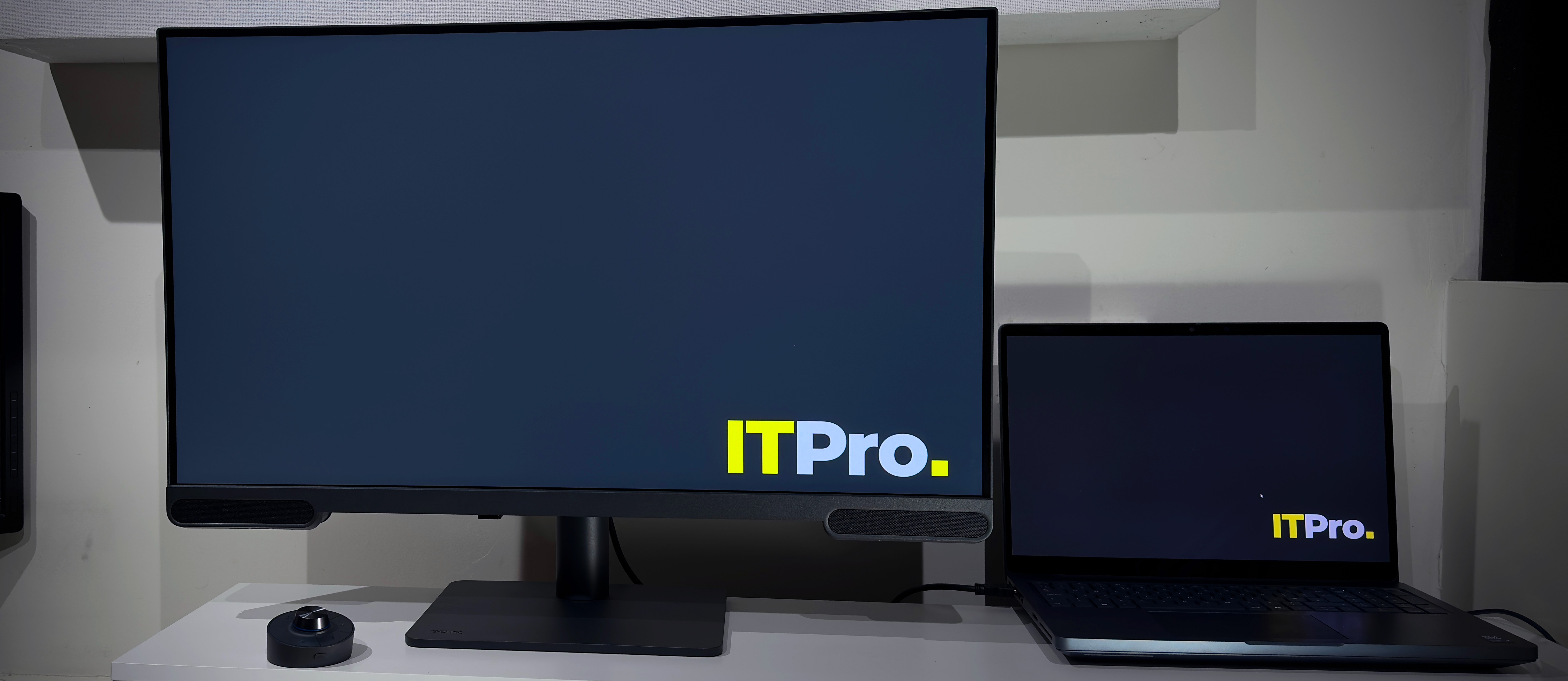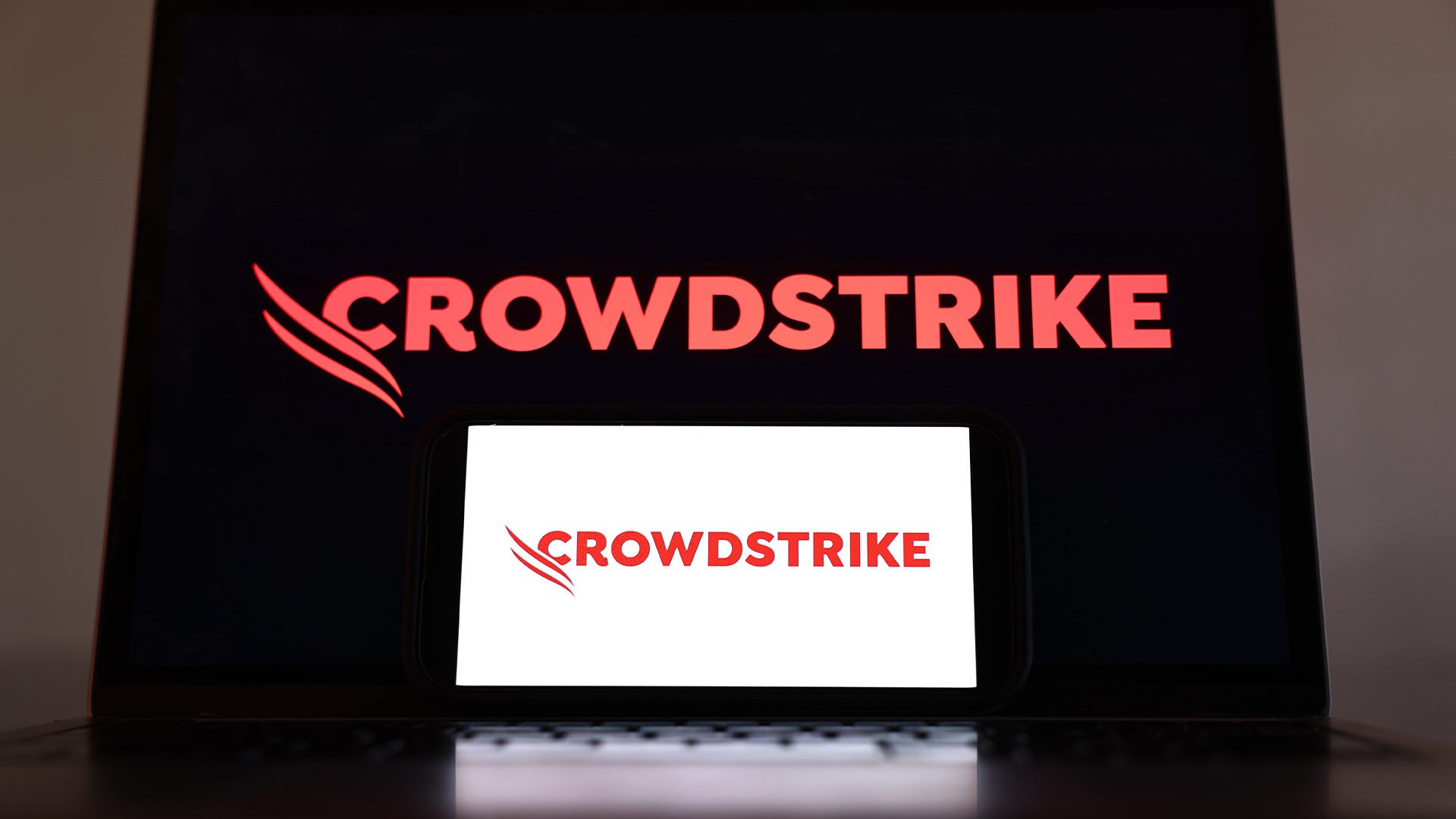BenQ PV3200U monitor review: Big value for content creators
A £699 32-inch 4K monitor for video editing – but it needs a few cuts to appeal to its target audience

-
+
Sharp, color-accurate 4K images
-
+
Hotkey Puck is ingenious
-
+
Calman Verified presets
-
-
Contrast is low
-
-
HDR brightness is lacking
-
-
Speakers are pointless

You can spend a small fortune on high-end monitors for content production, so it's no wonder that monitors such as the BenQ PV3200U look so very tempting. A color-accurate 4K panel with in-built 2.1 speakers for £700 looks like a bit of a bargain.
The specifications are quietly promising. The PV3200U partners a 32-inch 4K IPS panel with 95% DCI-P3 coverage and 100% Rec.709 coverage, an integrated set of 2.1 speakers, 65 watts of USB-C power delivery, and BenQ's helpful little Hotkey Puck controller.
The cherry on top is Calman Verified accreditation, which means that every monitor delivers a color-accurate performance straight out of the box. The question is whether it can compete with the new breed of OLED monitors, which are rapidly dropping in price – and only growing in appeal.
BenQ PV3200U monitor: Design & Features

BenQ has opted for an understated design that puts the spotlight on the screen. Every inch of the monitor is finished in a dark charcoal grey, and the result is a smart, unassuming monitor. The plastic construction does feel a bit lightweight, though. Drum the rear of the panel with your fingers, and it sounds hollow and rattly – that's a mild disappointment at the price.
There is ample adjustability, though. The tubular stand and wide base provide a super stable support for the 32-inch panel, and you get 115mm of really smooth-feeling height adjustment. There's ample tilt and swivel, and you can rotate the panel around clockwise into a portrait orientation if you need to.
Connectivity mostly hits the spot. DisplayPort is notably absent, but there are three HDMI 2.0 ports. You also get a downstream USB-C input, which supports DisplayPort Alt inputs and provides 65W of power delivery. This connection also powers the USB hub, which supplies one downstream USB-C port and three USB-A ports. There's a headphone output, too, if you need it.
One limitation here is that using the USB-C port for video means that you'll have to choose between 4K 60Hz images and USB 2.0 transfer speeds, and 4K 30Hz and 5Gbps USB transfer speeds. If you want 4K 60Hz and maximal USB throughput, then you'll need to use a USB-C cable for data and a separate HDMI cable for video.
Sign up today and you will receive a free copy of our Future Focus 2025 report - the leading guidance on AI, cybersecurity and other IT challenges as per 700+ senior executives
We've moaned about the design of BenQ's cable management clip before, and for good reason. The PV3200U has the same plastic collar, which clips to the stand, and it's just as ineffective as always. It can't handle more than a few cables at once, and has an annoying tendency to allow cables to escape if you adjust the stand height or position. Hopefully, the next generation will address the issue.
The PV3200U makes the unusual choice of adding an integrated 2.1 speaker system. There are two high-frequency drivers that protrude from the bottom left and right of the monitor, and a small woofer is located at the rear. Compared to most monitors, the sound is a huge cut above – although that's not saying much. There's enough clarity and just enough midrange and treble to make music listenable, although there's no proper bass to speak of – the frequency response drops off like a stone below 300hz.
There are multiple sound modes to choose from – Studio, Voice, Music, Cinema, and Game. Studio is intended to be the most accurate of the lot, but this just reveals the limits of the PV3200U's audio. There's no bass, not a huge amount of volume, and clarity is very middle of the road – it's nowhere near good enough to master audio with any confidence. If you just want to use the PV3200U, then the Cinema preset is the most pleasant-sounding of the lot. It boosts what little bass there is and adds a little more warmth to the midrange.
We are pleased to see that BenQ's Hotkey Puck has made another appearance, though. This little round device – or puck, if you like – allows you to adjust the monitor settings or quickly toggle between settings and display profiles of your choice without having to reach out to the monitor.
Four quick-access buttons and a back button surround a little silver clickable dial – and it works well. It operates via infrared, so does need to have a line of sight to the IR receiver underneath the monitor's front edge, but that shouldn't be an issue for most setups. If we had to find fault, it's that there is a bit of lag between the puck and the onscreen display, but it's not hugely annoying. It would be nicer if it were a touch more responsive.
The key here is customisability. You can assign different preset picture modes to the numeric buttons, for instance, or choose to assign them to the various HDMI inputs instead, to allow you to quickly flit from one device to another. It's a really neat idea, and well executed, too. As ever, the on-screen display is fairly simple – it's easy to find your way around and customise the various features as you see fit.
Users who own a colorimeter will also be able to take advantage of BenQ's Palette Master Ultimate software. This allows you to create specific picture presets for specific color spaces and white points, which is handy for maintaining color accuracy over time. This relies on software calibration; however, the PV3200U doesn't support hardware calibration via its internal LUTs. You'll also need to have a first-party colorimeter from a limited range of X-Rite, Calibrite, or Datacolour. The OEM models, like the i1Display Pro Plus we have here, are not supported.
BenQ PV3200U monitor: Display quality

Straight out of the box, the PV3200U arrives in its Display P3 picture mode. Colors look rich, skintones are subtle and believable, and despite the relatively low contrast ratio, both images and videos look good – at least in SDR.
That natural-looking image quality turns out a strong set of color accuracy results. The Display P3 profiles achieved an average Delta E of 1.06. The white point of 6,636k is a touch too warm, but it's not far off. Both gamma and greyscale tracking are close to perfect.
In fact, all the preset modes perform similarly: Switch to DCI-P3 and you get an average Delta E of 1.4, but the white point of 6,533k is well above the ideal 6,300k. The sRGB mode is also solid, with an average Delta E of 0.86 and, again, an overly warm white point of 6,725k.
BenQ claims a DCI-P3 coverage of 95% but we couldn't replicate this in our tests. Across the various wide gamut preset picture modes, we saw DCI-P3 coverage of between 89% and 91%. That's not bad, but it's a long way off from pricier panels – or similarly priced QD-OLED rivals, for that matter.
The bigger issue here is that the PV3200U's standard IPS panel has very low contrast. BenQ states that the "native contrast" is 1,000:1, but as uniformity compensation is enabled in the preset modes, the actual contrast in the calibrated modes is closer to 600:1.
The highest contrast ratio we saw in any of the tested modes was 626:1, which is a long way behind the IPS Black panels we've seen in Dell's UltraSharp range, and several orders of magnitude worse than OLED. This isn't too intrusive in brighter lighting conditions, but the apparent black depth is clearly inferior to the OLED panels on our test desk. Once the lights go down, the greyish blacks become very apparent.
The uniformity compensation does do what it says on the tin – but at the expense of both contrast and peak brightness. We measured a peak of 392cd/m2 and a 996:1 contrast ratio with uniformity off, but these figures were slashed to 204cd/m2 and around 600:1 with uniformity enabled. The benefit is that the panel's biggest brightness deviations occur on the right-hand side, and these aren't intrusive – every single one of the 24 measured points on the screen looks fairly consistent to the naked eye.
HDR performance is limited. It lives up to the DisplayHDR 400 certification – we recorded a peak brightness of 447cd/m2 on a 10% window – but that's as bright as it gets. While HDR content does still look good thanks to the accurate color reproduction, the lack of really bright highlights means that the impact is lost.
Motion clarity is fine, but it's not going to win any awards. The 60Hz refresh rate is one major limiting factor, and the panel's modest 5ms GtG rating is likely measured with overdrive engaged. BenQ's AMA overdrive feature is set to High by default, and this does subtly improve motion clarity compared to turning it off. As usual, though, we'd advise against upping the AMA setting to Premium, as this amplifies the subtle inverse ghosting of the High setting and leaves a very obvious bright fringe around moving objects.

BenQ PV3200U monitor: Is it worth it?
The biggest misstep here, in our opinion, is the decision to add speakers. While they're better than most integrated speakers, they're still far too much of a compromise – we wouldn't want to rely on them for mastering audio. If you have room on your desk for a 32-inch monitor, then you'd be far better off making a little more room for a decent set of active monitors. Good quality budget options will give a far more accurate reference for mastering audio than any speakers integrated into a monitor.
Where the PV3200U gets its priorities right is with image quality. The color-accurate sRGB, Rec.709, DCI-P3, and Display P3 modes are a boon, and while the low contrast and very limited peak brightness will make HDR grading tricky, it might do at a pinch. It certainly is a solid choice for standard definition work if you need color accuracy on a relatively tight budget.
One alternative would be to buy a similarly priced OLED rival. For instance, at the time of writing, the Dell 32 Plus S3225QC was reduced to just under £550. It's not a no-brainer, though: you've got to factor in inevitable burn-in if you're going to spend long periods in editing suites, and – just like the BenQ – you'll need to have a decent colorimeter and calibrate it to get the best results.
The final word is that the BenQ PV3200U would be far better without the speakers – and with a lower price to match. If you can find it discounted online, then it's a solid buy. With 20% off, you could add another star to the rating, so pop it on the shortlist and shop around.
BenQ PV3200U specifications
Display | 31.5 in IPS panel | Row 0 - Cell 2 |
Panel resolution | 3,840 × 2,160 | Row 1 - Cell 2 |
Refresh rate | 60 Hz | Row 2 - Cell 2 |
Panel response time | 5 ms (GtG) | Row 3 - Cell 2 |
Adaptive Sync Support | No | Row 4 - Cell 2 |
HDR Support | Yes – HDR10, VESA DisplayHDR 400 | Row 5 - Cell 2 |
Ports | HDMI 2.0 × 3, USB-C (65 W PD) × 1, USB-A downstream × 3, USB-C downstream × 1 | Row 6 - Cell 2 |
Other features | 100% sRGB, 100% Rec.709, 95% DCI-P3; built-in 2.1-channel speakers (2W × 2 + 5W woofer) | Row 7 - Cell 2 |
Stand | Tilt –5° to +20°, height adjustment 115 mm, swivel ±15°, pivot 90° | Row 8 - Cell 2 |
Dimensions (with stand) | 714.5 × 480.2-595.2 × 210.5 mm (WHD) | Row 9 - Cell 2 |
Weight (with stand) | 8.73 kg | Row 10 - Cell 2 |
Sasha is a freelance journalist who's been writing about tech and consumer products for over two decades. With a career that started at the dawn of the millennium on Computer Buyer magazine, he passed through the official Intel Centrino magazine, Mobile Computer, before rounding off his print career on PC Pro magazine where he reviewed a broad spectrum of hardware and software before eventually specializing in laptop and monitor reviews. After the best part of a decade, he defected to the desks on the other side of the office and spent many years working on Expert Reviews before finally going freelance in 2024. Nowadays, he splits his time between reviewing tech and home appliances, falling off mountain bikes and cleaning up his kids' playroom.
-
 If you're not taking insider threats seriously, then the CrowdStrike incident should be a big wake up call
If you're not taking insider threats seriously, then the CrowdStrike incident should be a big wake up callNews CrowdStrike has admitted an insider took screenshots of systems and shared them with hackers, and experts say it should serve as a wake up call for enterprises globally.
By Nicole Kobie Published
-
 Infosys co-founder Narayana Murthy called for a 70 hour week last year — now he says that’s not enough
Infosys co-founder Narayana Murthy called for a 70 hour week last year — now he says that’s not enoughNews Murthy thinks longer hours akin to China’s '996' approach are the key to success
By Ross Kelly Published
-
 The UK is dealing with a ‘substantial’ shortfall in digital skills — and up to three million jobs as businesses ramp up automation
The UK is dealing with a ‘substantial’ shortfall in digital skills — and up to three million jobs as businesses ramp up automationNews A new report suggests workers are falling short in the essential job skills of the future
By Emma Woollacott Published
